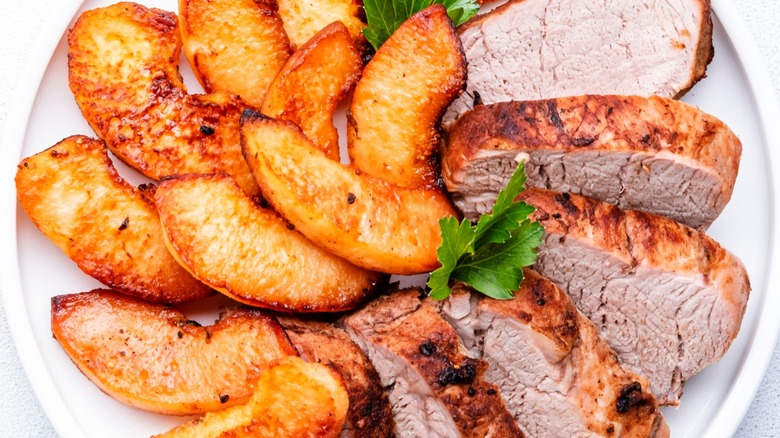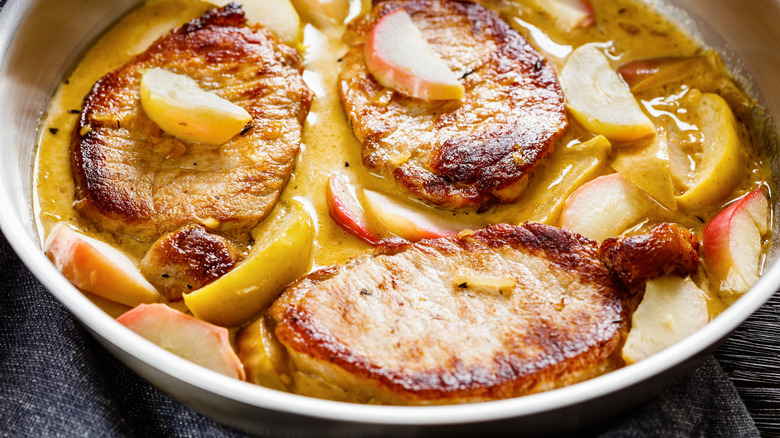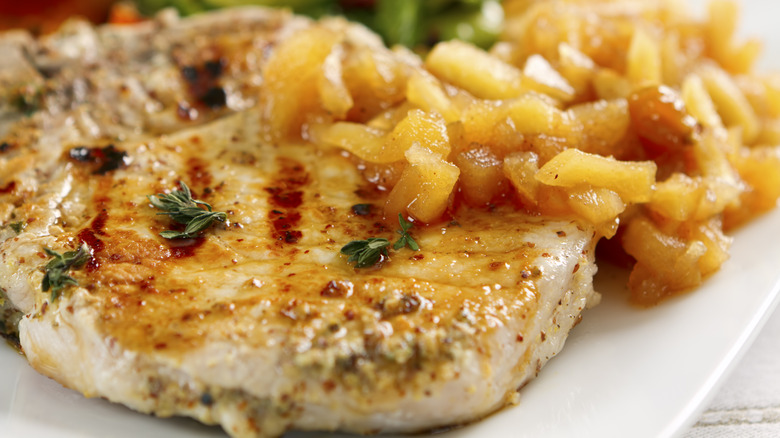Unraveling The History Of Pairing Pork With Apples
Historians have found that folks have been eating pork as early as 5,000 B.C., and foodies were trading apples along the Silk Road – the ancient trade route linking China, Rome, India, and the Mediterranean – dating back to before the 1200s. But when did it become customary to serve pork with apples? The sweet-savory profile of pork chops is complemented by tart, acidic apples, which also provide an interesting textural element.
The pairing is hearty, comforting, and warming — and seems natural from an agricultural standpoint. Apple harvest season in the fall coincides with the pig slaughtering season (also in the fall). To preserve these elements in the winter months during the early days of animal husbandry, pork was turned into sausage, ham, or bacon, and apples were turned into applesauce, keeping the pairing running all year long.
Putting pork and apples together could also have to do with an element of terroir. Before industrial farming, it wasn't uncommon for farmers to allow their pigs to graze in apple orchards, where they would chow down on fallen fruits. This was a thrifty move for farmers, who then had to spend less money and resources on making dedicated pig feed. But, in doing so, perhaps the pork was subtly infused with an apple-y flavor. Either way, the thread of proto-pork-and-apples traces back to the beginning of recorded human culinary habits.
Pork and apples are a tale as old as time, literally
The "Apicius," an ancient Roman cookbook compiled around the 9th century, includes a recipe called minutal matianum for roasted pork and apples — pork two ways, actually. Ground pork meatballs and cubed pork shoulder are roasted with diced Matian apples, stock, and chopped leeks, then seasoned with long pepper, cilantro, coriander, mint, silphium root, vinegar, honey, garum (fermented fish sauce), and defrutum (grape must reduction). The dish uses ingredients that would have been available to ancient Roman soldiers stationed in Britain.
From this point in the historical timeline, there's a pretty major gap between ancient Rome and the birth of America — where apples have always been kind of a big deal (remember Johnny Appleseed)? In the 1760 field guide "The House-keepers Pocket-Book," among the dishes suggested for "the Second Course [in January]" are "Hog's Head, roasted," "Hog's Hearslet, roasted" and "Hind Loin of Pork, roasted" – all served with applesauce.
Still, the exact chronological order of pork-and-apple dish development remains unclear. Perhaps simultaneously, foodies around the world were pairing the ingredients together, as in the classic French dish Porc à la Normade, pan-seared pork tenderloin with caramelized apples. A recipe for pork pie with apples also appears in the then-popular 1747 English cookbook "The Art of Cookery Made Plain and Easy." During the 18th century, few cookbooks were in print at all. This was one of them, and a pork with apples recipe made the final round of edits.
Evolving into an American identity
By the mid-1800s, pork and apples were a cemented culinary pairing in American households. In the 1858 play "Our American Cousin," the boorish American character Asa has a line of dialogue that uses the dish as a cheeky idiom, conveying the widespread cultural popularity of pork chops and applesauce as something a playwright could reference offhandedly and the audience would know what was meant: "Now I've no fortune, but I'm filling over with affections which I'm ready to pour out all over you like apple sass, over roast pork." (Incidentally, "Our American Cousin" was also the play that President Lincoln was attending at the time of his assassination in 1865 at Ford's Theatre.)
An 1893 issue of Good Housekeeping magazine includes a recipe for "Pork Chops and Apple Sauce," and a similar recipe appears in 1896's "The Boston Cooking-School Cook Book" by Fannie Merritt Farmer for fried pork chops with apple slices fried in the leftover fat. When meat was rationed during World War II, many home cooks turned to apples for bulk, stretching their allotted pork further. In many ways, pork and apples are a timeless pairing that has kept up with the times, and dishes like pork sausage and apples remain popular. The duo kept cropping up in American cookbooks throughout the 20th century. It's found in 1939's "Joy of Cooking" by Irma Rombauer — and 1991's "Food from an American Farm" by Janeen Sarlin has a recipe for pork chops and applesauce made in a Crockpot, bringing the culinary past into the present.


